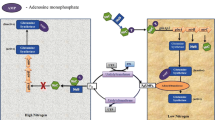Abstract
Biomethanation as a result of co-culturing methanogenic bacteria with sulphate-reducing bacteria was studied under anoxic conditions. Toxic sulphur compounds are known not to inhibit methanogenesis. Hence varying experimental conditions can lead to the optimum conditions for biomethanation. Under controlled experimental conditions, the interacting behaviour of both isolated methanogens and sulphate reducers show interesting features, viz. allelopathy.
Similar content being viewed by others
References
Allen, L.A. (1949) The effect of nitro-compounds and some other substances on production of hydrogen sulphide by sulphate-reducing bacteria in sewage. Proceedings of the Society for Applied Bacteriology, 2, 26–38.
Banat, I.M., Nedwell, D.B. and Balba, M.T. (1983) Simulation of methanogenesis by slurries of salt-marsh sediment after the addition of molybdate to inhibit sulphate-reducing bacteria. Journal of General Microbiology, 129, 123–129.
Breznak, J.A. (1988) Sporomusa termitida sp. nov., a H2/CO2 utilizing acetogen isolated from termites. Arch Microbiology, 150, 282–288.
Bryant, M.P., Campbell, L.L., Reddy, C.A. and Crabil, M.R. (1977) Growth of Desulfovibrio in lactate or ethanol media low in sulfate in association with H-utilizing methanogenic 2 bacteria. Applied and Environmental Microbiology, 33, 1162–1169.
Cappenberg, T.E. and Prins, R.A. (1974) Inter-relationships between sulfate-reducing and methane-producing bacteria in bottom sediments of a fresh-water lake. III. Experiment with C14 labelled substrates. Antonie Van Leeuwenhoek J. Microbiol. Serol., 40, 457–469.
Guyot, J.P. and Brauman, A. (1986) Methane production from formate by syntrophic association of Methanobacterium bryantii and Desulfovibrio vulgaris JJ. Applied and Environmental Microbiology, 52, 1436–1437.
Hilpert, R., Winter, J., Hammes, W. and Kandler, O. (1981) The sensitivity of archaebacteria to antibiotics. Zentralblatt fur Bakteriologie Mikrobiology und Hygiene I Abt Originale, C2, 11–20.
Hilton, M.G. and Archer, D.B. (1988) Anaerobic digestion of a sulfite-rich molasses wastewater: Inhibition of hydrogensulfide production. Biotechnology and Bioengineering, 31, 885–888.
Hungate, R.E. (1969) A roll tube method for the cultivation of strict anaerobes. In: (Norris, J.R. and Ribbons, D.W. eds.) Methods in microbiology, Vol. 3B. Academic Press Inc: New York, pp. 117–132.
Maclnerney, M.J. and Bryant, M.P. (1981) Anaerobic degradation of lactate by syntrophic associations of Methanosarcina barkeri and Desulfovibrio species and effect of H2 on acetate degradation. Appl. Environ. Microbiology, 41, 346–354.
Nedwell, D.B. and Banat, I.M. (1981) Hydrogen as an electron donor for sulfate-reducing bacteria in slurries of salt marsh sediment. Microbial Ecology, 7, 305–313.
Oremland, R.S., Marsh, L.M. and Polcin, S. (1982) Methane production and simultaneous sulphate reduction in anoxic salt marsh sediments. Nature, London, 296, 143–145.
Pfennig, N., Widdel, F. and Truper, H. G. (1981) The dissimilatory sulfate reducing bacteria. In: (Starr, M.P., Stolp, H.G., Truper, H.G., Balows, A. and Schlegel, H.G. eds.) The Prokaryotes, Vol. 1. Springer-Verlag: Berlin, pp. 926–940.
Saleh, A.M., Macpherson, R. and Miller, J.D.A. (1964) The effect of inhibitors on sulphate reducing bacteria: a compilation. Journal of Applied Bacteriology, 27, 281–293.
Winfrey, M.R. and Zeikus, J.G. (1977) Effect of sulfate on carbon and electron flow during microbial methanogenesis in fresh water sediments. Applied and Environmental Microbiology, 33, 275–281.
Yadav, V.K. and Archer, D.B. (1988) Specific inhibition of sulfate-reducing bacteria in methanogenic co-culture. Letters in Applied Microbiology, 7, 165–168.
Author information
Authors and Affiliations
Rights and permissions
About this article
Cite this article
Chakraborty, N., Sarkar, G.M. & Lahiri, S.C. Effect of co-culturing of methanogens with sulphur-reducing bacteria on biomethanation. The Environmentalist 20, 29–31 (2000). https://doi.org/10.1023/A:1006647809586
Issue Date:
DOI: https://doi.org/10.1023/A:1006647809586




